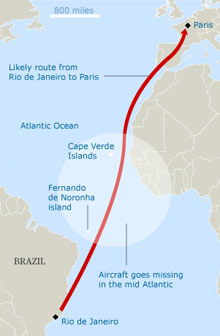 Air France flight 447
Air France flight 447
Air France flight 447 went missing on its way from Brazil to France. The plane left Rio de Janeiro Galeão International Airport at 2203GMT on the 31st May 2009, and was expected in Paris Charles de Gaulle Airport at 0910GMT on the 1st June 2009. The plane dropped off Brazil's civilian radar screens at 0133GMT and off Brazil's Air Force radar at 0148GMT about 351km northeast of the coastal Brazilian city of Natal, having just passed the archipelago of Fernando de Noronha - at this point the plane appeared to be flying normally. At 0200 the pilot reported thunder storms and turbulence. The last contact with the plane was at 02:14GMT when it had sent up to 24 automatic signals over a 4 minute period to Air France maintenance computers on the ground, indicating inter alia that the autopilot had disengaged and a possible loss of pressure (the last signal was sent some 640km northeast of Fernando de Noronha Island). There was no distress call from the pilots. At 0220 the plane failed to make previously scheduled radio contact with Brazil Air Traffic Control, and Brazil Air Traffic Control notified air traffic control in Dakar, Senegal. Between 0500 & 0600 GMT Brazilian, African, Spanish and French air traffic control centers try to make contact with the flight, but are not successful. At 1444 GMT the plane would have run out of fuel, if it was still flying.
Interim report on Air France flight 447 (30 Nov 2009) |
Some bodies identified
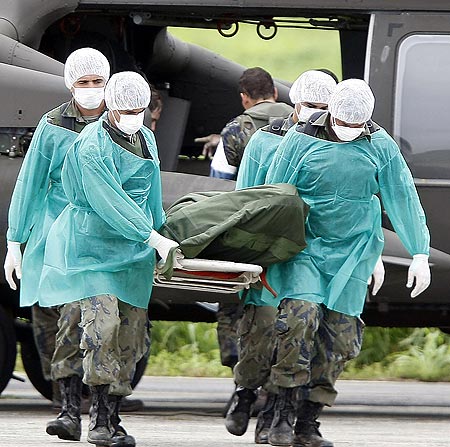 The following bodies have been identified:
The following bodies have been identified:
-
the chief pilot (Marc Dubois), implying that, in keeping with usual practice, he was not at the control during the cruise phase of the flight. The first and second officers would probably have been flying (they would have been seat-belted and unlikely to have been thrown clear of the enclosed flight deck).
-
Graham Gardner, a UK citizen & employee of Subsea 7, an Aberdeen-based oil company. Gardner lived in Gourock, Inverclyde.
-
a flight attendant
-
3 Germans (2 men from Bavaria & a woman from Hamburg)
-
8 Brazilians,
-
1 with joint German-Brazilian citizenship,
-
1 Swiss-Brazilian
50 bodies found (most without clothing)
The R-99, a Brazilian Air Force plane, found the first body from Air France flight 447 floating in the Atlantic. Based on information from R-99, the corvette Caboclo and a C-130 was sent to the area. On the morning of the 6th June 2009 the corvette Caboclo, a Brazilian Navy ship, picked up two male bodies (the first at 0930, the second at 1113) some 850km northeast of the Fernando de Noronha islands. At the same time the Corvette Caboclo recovered:
-
a leather briefcase with an Air France ticket for flight 447 inside it, which Air France confirmed corresponds to a passenger who was on the doomed flight.
-
A nylon backpack with a vaccination card and laptop in it.
-
a blue seat with the series number 23701103B331-0 (Air France are still to confirm whether it belongs to flight AF 447).
-
Oxygen masks
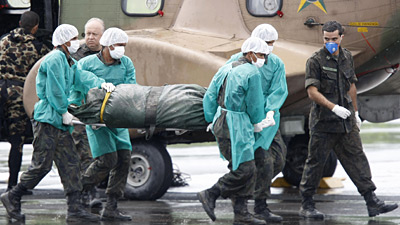
Fourteen more bodies were recovered (by the Brazilian Navy & French ships) on the 7th June in the same area as the previous 2. On the 8th June 2009 eight more bodies were recovered in the same area. On the 9th June 2009 17 more bodies were recovered, and the first 8 bodies found were flown by helicopter to Fernando de Noronha. No bodies were recovered on the 10th June, due to bad weather. On the 11th June 3 more bodies were recovered by the Brazilian Navy Ship Constitution, after being spotted by an aircraft searching debris or bodies from flight 447 (no further plane debris was recovered on the 11th June). On the 12th June 6 more bodies were recovered. On the 16th June 1 more body was found and recovered by the Caboclo, a Brazilian Navy Corvette.
Most bodies were found without clothing
Most of the bodies were found without clothing, which could possibly have been taken off by the wind during their fall (further evidence that they were sucked out of the plane). It's therefore possible that the bodies which have been found were those sucked from the plane, and that the majority of the remaining bodies are fixed to their seats in the hull of the plane (presumably underwater).
No burns
Prelimanary analysis of the bodies indicates that they didn't suffer any burns, indicating that there was not an explosion and that the plane broke apart mid-air.
No water in lungs, multiple fractures
The bodies had no water in the their lungs, indicating they did not die from drowning, but had multiple fractures.
Bodies delivered to Recife
Bodies will be delivered to the airport at Fernando de Noronha island and then to Recife for identification. Rescuers believe that some bodies may have been consumed by sharks or have sunk.
Bodies widely dispersed
The bodies have been found dispersed as much as 85 miles apart, indicating that the plane probably broke up over several minutes whist in the air, with the passengers sitting helpless and occassionally some being sucked out.
Warm water means bodies sink quicker
An intact body will typically float for 2 or 3 weeks. The warmer the water the quicker the process of a body surfacing, floating and then sinking once again; as a result of the increased amount of marine life which breaks the bodies down. The water in which the bodies of flight 447 lies, is 28 degrees celsius.
Personal items
Numerous other personal items belonging to the passengers have been found, but authorities are not revealing what they are. All personal items are being handed to Air France, who will deliver them to the families of the Flight 447 victims.
Search called off
On Friday the 26th June 2009 Brazil called off the search for bodies & debris (the search for the black box continued).
Manslaughter investigation
Relatives of a victim have signed up as a civil plaintfill in a manslaughter investigation at the Paris Prosecutor's office, in order to get access to files explaining why Air France flight 447's airspeed sensors hadn't been replaced. Two other French families have independently filed suit in Paris for manslaughter.
Two passengers on terrorist watch list
French secret servicemen have established that 2 passengers on board flight 447, are also on highly-classified documents listing the names of radical Muslims considered a threat to the French Republic. The French Ministry of the Interior have said it was a coincidence.
Italian who missed AF447 dies in car crash
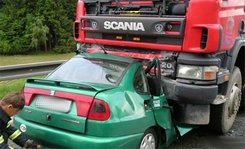 Johanna Ganthaler, an Italian lady from the Bolzano-Bozen Province - South Tyrol, was lucky enough to arrive late for AF447 and missed the flight. Her and her husband Kurt caught a flight later in the day from Rio de Janeiro to Munich. However, like in the movie Final Destination, fate finally caught up with Johanna and she died in a head-on collission when their car swerved into a truck coming from the opposite direction. The accident occurred near Kufstein, Austria. Kurt Ganthaler was also injured in the accident.
Johanna Ganthaler, an Italian lady from the Bolzano-Bozen Province - South Tyrol, was lucky enough to arrive late for AF447 and missed the flight. Her and her husband Kurt caught a flight later in the day from Rio de Janeiro to Munich. However, like in the movie Final Destination, fate finally caught up with Johanna and she died in a head-on collission when their car swerved into a truck coming from the opposite direction. The accident occurred near Kufstein, Austria. Kurt Ganthaler was also injured in the accident.
Did pilot try turn around in mid-flight?
The search area lies southeast of the last jet transmission, indicating that the pilot could have been trying to turn around in mid-flight and head to the Fernando de Noronha islands.
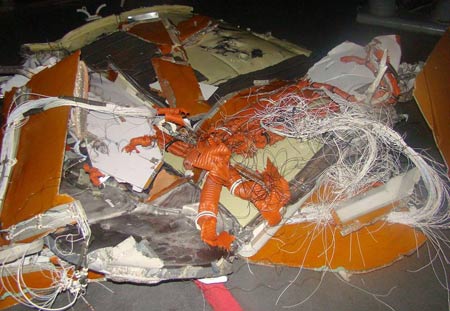
Faulty airspeed indicators not replaced
In September 2007 Air France had received a recommendation (the recommendation was not mandatory) from Airbus to replace airspeed instruments (called pitot tubes - open-ended, forward-facing external tubes) on the plane with a new sensor originally developed for the smaller Airbus A320, but had not yet done so for its entire fleet. Airbus recommeded the replacement because the pitot tube tended to collect moisture, resulting in inaccurate airspeed readings.
After the recommendation from Airbus, Air France replaced the airspeed instruments on its Airbus A320 aircraft because water occasionally leaked into the device on those planes, A replacement program "was not implemented on the longer haul A340/330s as no such incidents had been noted."
On the 6th June 2009, Air France said that it was accelerating the replacement of the speed sensors on all Air France Airbus long-haul planes.
On the 8th June 2009 Alter, Air France's 3rd-largest pilots’ union, urged its members to stop flying Airbus A330s until 2 of the 3 components on the planes had been upgraded.
Pitot tubes are named after the French engineer Henry Pito, who in the early 1700s figured out that the pressure of a gas or liquid through a tube could be used to determine velocity.
Other airlines begin replacing airspeed monitors
Delta Air Lines is upgrading its Airbus A330s under plans made before the flight 447 incident. Aer Lingus is “prioritizing modification” of 2 Airbus A330s carrying the older pitot tube model in response to accident. US Airways began replacing its Airbus A330s’ pitot tubes after the Air France flight 447 accident “out of an abundance of caution”.
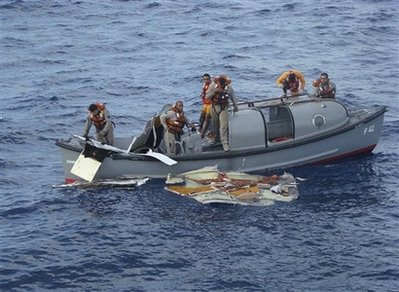 "Air France Village" in mourning
"Air France Village" in mourning
The village of Ermenonville is known as "Air France Village", because of the number of Air France employees amongst its population of 913 (it is close to Paris Charles de Gaulle Airport). Sadly, 3 of Air France Village's municipal councilors were on flight 447 — Anne Grimout (head of the cabin crew), Nathalie Marroig & Marie-Josée Treillou. Anne had convinced Nathalie & Marie-Josée to join her on a trip o Brazil.
Wreckage
At 1520GMT on the 2nd June 2009, a Brazilian Air Force plane (Embraer R99) spotted wreckage near St. Peter and Paul Rocks, some 640 km northeast of the Fernando de Noronha islands. The wreckage stretched for 5km and included "white pieces and electrical conductors", an airplane seat, a fuel slick, pieces of white debris and an orange buoy . The floating debris was spread out in 2 areas about 60km apart, indicating that the plane may have broken up before hitting the water.
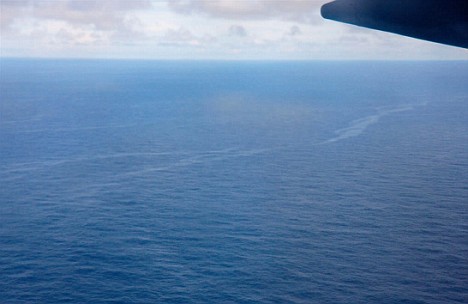
Debris recovered not from AF447
On the 4th June a cargo pallet and 2 buoys were recovered by a Brazilian helicopter crew working off a Brazilian navy ship. The cargo pallet was proven not be from AF447. 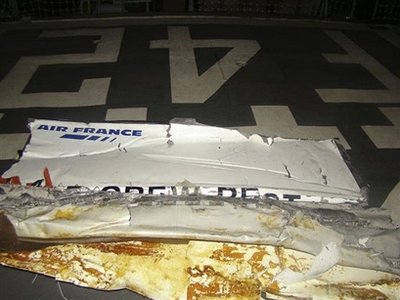
Tail fin
The recovery of the tailfin is significant because the flight recorders were mounted in the tail section, and the tail fin's location could indicate an approximate underwater location for the flight recorders (black box).
Nuclear submarine
On 5 June Hervé Morin, the French defence minister, said that the nuclear submarine Émeraude was being sent to the search area.
ACARS data maintenance transmission
ACARS refers to Aircraft Communication Addressing and Reporting System, a system whereby planes automatically report faults to the flight maintenance team. The messages begin with a routine one at 2245GMT, a problem in one of the lavatories. But from 0210GMT until 0214GMT a total of 24 automatically transmitted data maintenance messages were sent from Air France flight 447. At 0210GMT the autopilot had disengaged & the "fly-by-wire" went into "alternative law" flight control mode, which occurs when there are multiple failures of redundant systems. At 0213GMT messages reported the failure of systems to monitor altitude, air speed, and direction. Control of the wing spoilers & main flight computer also failed. At 0214GMT a final message was received indicating rapid cabin depressurisation (that advisory may mean the plane had depressurised or broken up in the air)
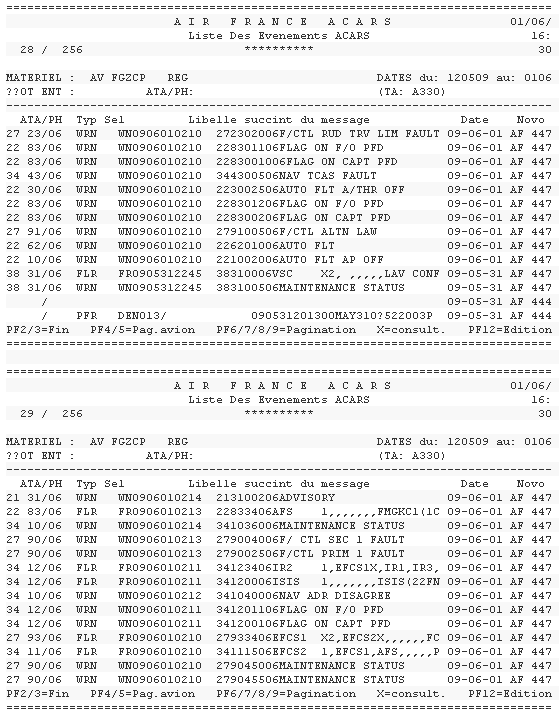
Interpretation of ACARS data maintenance transmission
At the top of the document is the page number - page 28 of 256 (further down is page 29 of 256). Under the heading "Typ" is the type of messsage - messages of type WRN are warnings, and type FLR are fault reports. Under the heading "Sel", the first 2 digits again indicate the type of message (WN or FR) and then the date (e.g. WN0906010214 indicates warning message received at 0214GMT on the 1st June 2009). The messages are sent in batches, and the sequence within a batch is not meaningful.
The oldest messages received at 0210GMT is at the bottom of page 29, under the left-hand column "ATA/PH" look for "34 11/06":
-
"34 11/06 FLR FR0906010210 34111506EFCS2"
This message means:
-
ATA 34 (navigation)
-
11 (Sensors Power supply and switching)
-
15 (Pitot probes)
-
06 (cruise)
With the consequent failure FLR 27933406 (Flight control primary computer en route), then the long list of messages WRN (warning).

Airbus telex regarding unreliable airspeed indications
"FROM : AIRBUS FLIGHT SAFETY DEPARTMENT TOULOUSE
ACCIDENT INFORMATION TELEX - ACCIDENT INFORMATION TELEX
SUBJECT: AF447 ACCIDENT INTO THE ATLANTIC OCEAN
OUR REF: AF447 AIT 2 June 4th 2009
PREVIOUS REF:
- Ref 1: AF447 AIT 1 dated June 1st 2009
This AIT is an update of the previous AIT n°1 concerning the AF447
accident into the Atlantic ocean on June 1st, 2009.
In line with the ICAO Annex 13 recommendations, the French
investigation Board - BEA (Bureau 'Enquêtes et d'Analyses) is
leading the technical investigation, with accredited representatives
from the Brazilian Investigation Board and US NTSB, with Airbus
providing technical support.
The following data have been approved for release by the French BEA.
The route of the aircraft was crossing a tropical multicell
convective area at the time of the accident.
Failure/ maintenance messages have been transmitted automatically
from the aircraft to the airline maintenance center.
The above mentionned messages indicate that there was inconsistency
between the different measured airspeeds. Therefore and without
prejudging the final outcome of the investigation, the data available
leads Airbus to remind operators what are the applicable operational
recommendations in case of unreliable airspeed indication.
The following operational procedures are available for the Airbus
Aircraft Type :
-A300: QRH 13.01 thru 13.03, FCOM 8.05.10;
-A310: QRH 13.01 thru 13.03, FCOM 2.05.80;
-A300-600: QRH 13.01 thru 13.03, FCOM 2.05.80;
-A318/A318/A320/A321 family: QRH 2.15 thru 2.18A, FCOM 3.02.34;
-A330/A340 Family: QRH 2.21 thru 2.23B , FCOM 3.02.34;
-A380: ECAM not-sensed procedures, FCOM - Procedures / ECAM
Abnormal and Emergency Procedures / 34 Navigation.
An update on the accident data will be provided as soon as further
valuable information is approved for release by the Investigation
Board."
Cause of the crash
The lack of a distress call from the pilots suggests 2 possibilities:
-
a sudden breakup of the airframe in flight (caused by a bomb, missile or fuel tank explosion)
-
the radios were inoperative or had lost power (which would be odd since the automated data transmission system was functioning).
A sudden breakup of the airframe seems most likely, as the debris has been found in two patches 35 miles apart. Could it be that the rare event of lightning igniting the fuel tank caused an explosion ripping apart the airframe of AF447?
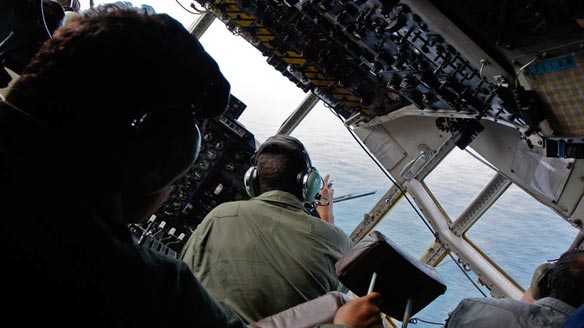
Second accident for plane
This same plane (registration F-GZCP) was involved in a ground collision on the 17th August 2006 when it had a ground altercation with another Air France A321 (F-GTAM) at Paris Charles de Gaulle Airport. F-GTAM was on its way from Paris Charles de Gaulle to Rome and F-GZCP was on its way from Paris Charles de Gaulle to Ouagadougou. Both aircraft suffered damage and the tail of the A321 was substantially damaged when it was hit by the taxiing A330. Damage to the A330 was considered as minor.
Those who escaped death
French couple's "miraculous" escape
"We should have been on the plane," Claude Jaffiol, a medical professor, said. Jaffiol had been in Brasilia for a seminar and had stayed for a few days of tourism, but decided to fly home earlier than planned. Despite having "moved heaven and Earth" and tried to enlist a diplomat friend to pressure Air France to let them on flight AF447, they were turned away because it was full. Amina Benouargha-Jaffiol says: "Of course, at some level we feel lucky, but we also feel an enormous sadness for all those who perished".
Andrej is saved by arriving early
Andrej Aplinc, a father of 2 and 39-year-old Slovenian sailor, arrived at the Rio de Janeiro Galeão International Airport early because his cab driver was in a hurry to see a football match. He discovered there was no seat on flight 447 with enough legroom for him to stretch out his bum knee, so changed to an earlier 4 p.m. Air France flight, which did have a roomy seat.
Hunch prompts Dutch man to cancel flight
Stefan van Oss had booked a holiday to Brazil and was due to return to Amsterdam on AF447 via Paris (he lives in the small town of Oss some sixty four miles from Amsterdam). At the last minute he cancelled his flights and holiday, after a friend warned him of danger.
Disaster management
At 0715 GMT Air France drew up plans to establish a crisis centre, and at 0935 GMT Paris Airport Officials announced to the public that flight AF 447 was missing (although at midday, the flight was still up on the arrivals board with the word "delayed" beside it). At 1017GMT Brazil's Air Force announced that a search and rescue mission was underway near the Brazilian island of Fernando de Noronha.
At 1213 GMT air France suggested the electrical fault may have been caused by the plane suffering a lightning strike (despite the fact that the plane has been built to deflect lightning bolts, and this rarely causes planes to crash). The last time lightning was blamed for causing a major crash was in 1963 when Pan Am flight 214, a Boeing 707, exploded over Maryland after a bolt of lightning ignited fumes in a fuel tank.
Air France said it has asked France's civil aviation agency to investigate the incident, and had sent all the information it had on the flight to Airbus and the French civil aviation authority.
Search effort
The Brazilian Air Force began a search at 0230 Brasilia time on the 1st June 2009, near Fernando de Noronha. The search effort used 5 planes (including an Embraer P-95 Bandeirante and a Lockheed C-130 Hercules), 3 boats and 2 helicopters. A French Breguet Atlantique plane left from Senegal in Africa to help in the search.

Air France's deadliest aeronautic disaster
With 1 June being a French bank holiday, the plane was nearly full, , with 228 lives (12 crew and 216 passengers) on board. Of the passengers, 126 were men and 82 were women. Seven children and a baby were on board. There were 3 pilots on board and 9 flight attendants. This is Air France's deadliest aeronautic disaster.
Nationalities
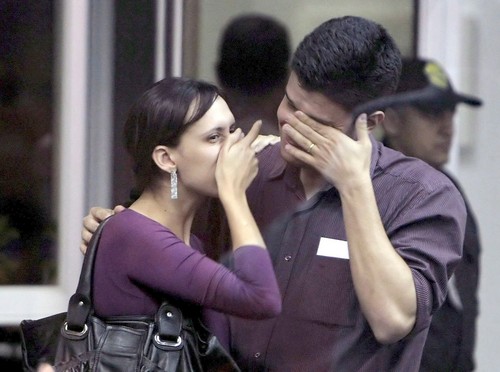
|
Passengers |
Crew |
France |
61 |
11 |
Brazil |
58 |
1 |
Germany |
26 |
0 |
Italy |
9 |
0 |
China |
9 |
0 |
Switzerland |
6 |
0 |
UK |
5 |
0 |
Hungary |
4 |
0 |
Norway |
3 |
0 |
Ireland |
3 |
0 |
Slovakia |
3 |
0 |
Morocco |
2 |
0 |
Poland |
2 |
0 |
Spain |
2 |
0 |
USA |
2 |
0 |
Argentina |
1 |
0 |
Austria |
1 |
0 |
Belgium |
1 |
0 |
Canada |
1 |
0 |
Croatia |
1 |
0 |
Denmark |
1 |
0 |
Estonia |
1 |
0 |
Netherlands |
1 |
0 |
Gambia |
1 |
0 |
Iceland |
1 |
0 |
Philippines |
1 |
0 |
Romania |
1 |
0 |
Russia |
1 |
0 |
South Africa |
1 |
0 |
Sweden |
1 |
0 |
Turkey |
1 |
0 |
Prize winners on flight
Nineteen of the French were on board the flight as a result of a Brazilian holiday being won by a company sales team (the 9 winners, aged between 25 & 35, were allowed to take partners and an executive also accompanied them). The company was CGED electrical equipment supplier.
Michelin
Two Brazilian and one French executive of French tire make Michelin, including its President for South America (Luis Roberto Anastacio, 50), were on board the flight.
Rio's government chief of staff
Marcelo Parente, Rio's government chief of staff, was reportedly on board.
ThyssenKrupp
Erich Heine, chairman of chairman of Companhia Siderurgica do Atlantico and a member of ThyssenKrupp Steel's (a German steelmaker) executive board, was on board.
Huawei
An employee of the Chinese company Huawei, was on board.
Fourth in line to Brazilian throne
Prince Pedro Luís of Orléans-Braganza, who would have been fourth in line to the extinct throne of Brazil (the Brazilian royal family has been out of power since 1889), was on board.
Irish docters
Three Irish docters travelling on the flight were Aisling Butler, of Roscrea, Co Tipperary, Jane Deasy of Dublin and Eithne Walls, originally from Belfast. Dr Walls was a member of the Riverdance troupe and performed on Broadway before beginning 6 years of medical studies at Trinity College Dublin. While studying, she continued dancing as part of Riverdance’s “flying squad”, performing in China, Qatar, Germany and France.
US Geologist & wife
A US Geologist & his wife, Michael & Anne Harris, were on board. Michael Harris worked in Rio de Janeiro for Oklahoma City-based Devon Energy Corporation.
Scottish Captain
Graham Gardner, master of a pipe-laying and construction vessel (the Lochnagar), was on the flight on his way back to his wife (he worked month-on month-off in Brazil).
He wasn't meant to be on the flight
Patricia Coakley's husband Arthur, a 61-year-old English oil-rig structural engineer for PDMS, shouldn't have been on the flight at all. He was supposed to have taken a weekend flight out of Rio de Janeiro, but was bumped because it was overbooked.
Other named passengers
A list of the named crew and passengers:
-Stephane Artiguenave, 35; French; salesman at electrical distributor CGED
-Sandrine Artiguenave, 34; French
-Pierre-Cedric Bonin, 32; French; co-pilot of AF447
-Isabelle Bonin, 36; French; wife of AF447 co-pilot Pierre-Cedric Bonin
-Aisling Butler, 26; Irish, of Roscrea, Ireland; doctor
-Brad Clemes, 49; Canadian from Guelph, Ontario; Coca-Cola executive
-Jane Deasy, 27; Irish; doctor
-Pedro Luis de Orleans e Braganca, 26; Brazilian; descendent of Brazil's last emperor
-Marc Dubois, 58; French; flight captain of AF447
-Jozsef Gallasz, 44; Hungarian; partner of Hungarian victim Rita Szarvas.
-Antonio Gueiros; Brazilian; information systems director, Michelin
-Michael Harris, 60; American, from Lafayette, Louisiana; geologist
-Anne Harris; American, from Lafayette, Louisiana
-Erich Heine, 41; South African-born; member of executive board of ThyssenKrupp Steel AG. Erich's family suffered a second tragedy on the 5th of June 2009, when his stepfather, James Douglas Long, died in hospital. Erich Heine leaves behind his wife, Alet, and daughters, Kristen, 6, and 4-year-old twins, Melissa & Anja.
-Claus-Peter Hellhammer, 28; employee of ThyssenKrupp Steel AG based in Germany
-Giovanni Battista Lenzi, Trentino area, Italy
-Zoran Markovic, 45; Croatian, from Kostelji, Croatia; sailor
-Christine Pieraerts; French; engineer at Michelin
-David Robert, 37; French; co-pilot of AF447
-Rita Szarvas; Hungarian; therapist at a Budapest center for children with motor disabilities (Peto Institute of Conductive Education) and the Conductive Learning Centre in Grand Rapids, Michigan, USA. Rita's 7-year-old son, Andras Szavas, was also aboard. Andras was a pupil at Sandpits Infants School.
-Eithne Walls, 29; Irish; doctor
- Pablo Dreyfus; Argentina; campaigner against the illegal drugs & arms trade.
-Rino Zandonai; Trentino area, Italy.
-Luigi Zortea; Trentino area, Italy.
- Arden Jugueta; Philippines; a Filipino seaman working as a mechanic of Elburge Ship Management, an Italian shipping firm based in Brazil. Arden was married to Miguela Jugueta, who was not on the flight.
- Marie-Josée Treillou, 70, from Ermenonville ("Air France Village") in Paris, France; a mother and grandmother who had lived in Ermenonville longer than fourty five years. She was persuaded by Anne Grimout, was head of the cabin crew, to come for a weekend trip to Brazil.
- Nathalie Marroig, 41, from Ermenonville ("Air France Village") in Paris, France; worked at Poclain Hydraulics in a nearby town & had children in Ermenonville school. She was persuaded by Anne Grimout, was head of the cabin crew, to come for a weekend trip to Brazil.
- Shlomo Anidjar, from Boulogne-Billancourt, France. French rabbis objected to Anidjar's 3 children's request to cite the Kaddish Yatom prayer ("orphan's Kaddish") for their father, and undertook mourning customs at Paris' Great Synagogue. The rabbis objection was based on the fact that the plane's debris and passengers' bodies had not been found, and that taking part in the Paris memorial would be seen as a rabbinical-halachic approval that the Shlomo's wife woman was a widow, when she is in fact considered an aguna (abandoned wife). Rabbi Yirmiyahu Menachem Cohen convened Paris' rabbinical court, where the court ruled that the children and woman could mourn Shlomo's death, as the woman was expected to be recognised as a widow in the future. The court stressed, however, that the woman was not allowed to remarry before a thorough discussion was held on her personal status.
Help numbers
Air France have set up some phone numbers for friends and relative to obtain information on whether or not a family friend or relative was on board:
0800 800 812 in France |
0800 881 20 20 in Brazil |
+33 15 702 1055 (other countries) |
Air France were taking care of families in a specially reserved area of Paris-Charles de Gaulle Terminal 2.
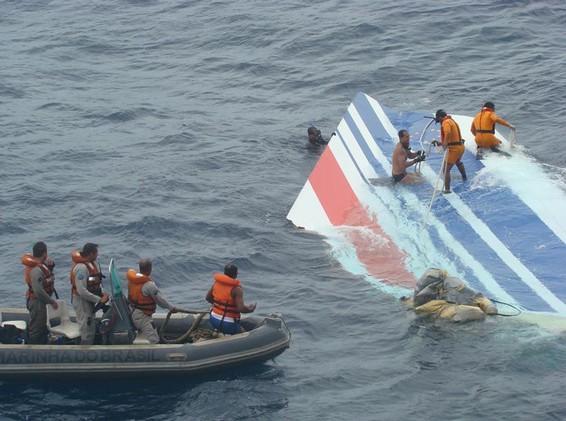
Flight 447 Pilots & crew
It is not clear which of the pilots were piloting the plane at the time of the accident (during long flights the captain may take a break to remain alert).
Captain
The Air France flight 447 captain, Marc Dubois, was 58 years old and had flown 11,000 hours. Like his father, he grew up to be a pilot, and like his father he flew for Air France. Marc had been flying for Air France since 1988, when he joined the airline from Air Inter, a rival French domestic carrier (which in 1990 merged with the Air France group). in February 2007 Marc qualified to fly the Airbus A330, and since then he had built up some 1,700 hours flying the aircraft.
Co-pilots
Dubois' co-pilots on flight 447 were Pierre-Cedric Bonin and David Robert. Bonin, 32, joined Air France in 2004, and had 3,300 flight hours and had qualified to fly Airbus A330s in June 2008. Robert, 37, joined Air France in 1999 and had 6,600 flight hours with the airline, becoming qualified to fly the Airbus A330 in April 2002.
Bonin's wife Isabelle, 38, went with him to Brazil and was on the flight that crashed. Isabelle taught at a Bordeaux high school.
Head of the cabin crew
Anne Grimout, 49, was head of the cabin crew. Anne was from Ermenonville, France (known as "Air France Village, because of the number of Air France employees amongst its residents), and had worked for Air France for nearly 25 years.
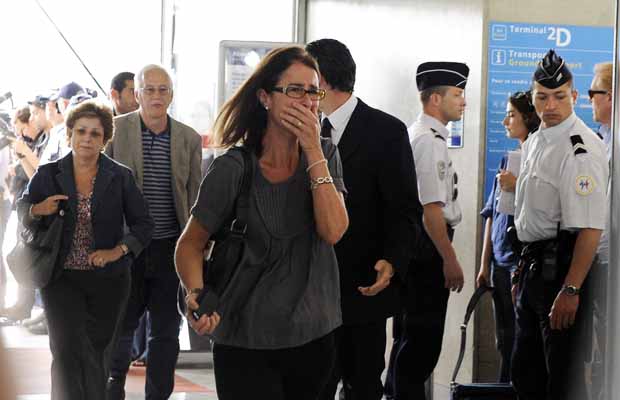
Memorial service
An ecumenical service was held at Notre Dame de Paris on the 3rd June 2009, in honor of the people aboard the flight
Plane
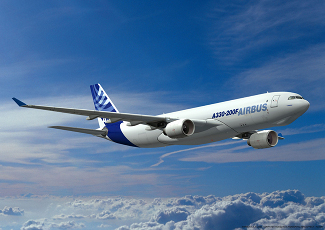 The twin-engined Airbus A330-200 had registration number F-GZCP, and was built (fitted with General Electric engines CF6-80E) and delivered to Air France in 2005, it went into service on 18 April 2005 and had flown 18,870 hours (first flight 25 Feb 2005). The plane has a 12,500km range and can carry up to 253 passengers. The plane last received an engineering overhal on the 16th April 2009. This is believed to be the first passenger-carrying Airbus A330 to crash. In June 1994, an Airbus A330 (owned by Airbus) on a test flight simulating an engine failure on take-off crashed after leaving Toulouse (France), killing all 7 people on board.
The twin-engined Airbus A330-200 had registration number F-GZCP, and was built (fitted with General Electric engines CF6-80E) and delivered to Air France in 2005, it went into service on 18 April 2005 and had flown 18,870 hours (first flight 25 Feb 2005). The plane has a 12,500km range and can carry up to 253 passengers. The plane last received an engineering overhal on the 16th April 2009. This is believed to be the first passenger-carrying Airbus A330 to crash. In June 1994, an Airbus A330 (owned by Airbus) on a test flight simulating an engine failure on take-off crashed after leaving Toulouse (France), killing all 7 people on board.
In total there have been 4 hull losses of Airbus A330s in non-commercial flights.
The Airbus 330 which entered commercial service in 1994, is built at Toulouse, France. in the south of France and entered commercial service in 1994. There are more than six hundred of this type of Airbus in service.
Highly automated systems
There is suspicion amongst some pilots about the Airbus's highly automated systems. Electrical problems in a fly-by-wire aircraft are extremely serious. Airbus planes are designed for computers to override pilots if the plane is in a dangerous situation. But if computers get bad input signals, the flight control system could possibly get disoriented and send the plane plunging.
Last Air France incident
Air France's last major incident was in July 2000 when an Air France Concorde airliner crashed just after taking off from Charles de Gaulle Airport (all 109 people on board died, and also at least 4 on the ground).
World's worst crash since 2003
This is the worst crash since 2003, when a plane carrying members of the Iranian Revolutionary Guard crashed in southern Iran, killing 275.
Third Brazil crash since 2006
Jul 2007 |
A TAM airliner crashes on the runway at the São Paulo airport, killing 187 people on board and 12 outside the aircraft. |
Sep 2006 |
A Gol jet , built by Boeing, crashes over the Amazon, killing 154 occupants. |
First plane crash between Europe & South America
This is understood to be the first time a plane has crashed between Europe & South America (or vice versa) since the route was first flown in 1947.
PPRUNE server too busy
PPRUNE, the Professional Pilots Rumour Network, couldn't initially be accessed for information about the missing Air France plane, giving the message, "The server is too busy at the moment. Please try again later."
Turbulent weather
Here's an indication of the turbulent weather flight 447 faced. The tropical storm the Airbus encountered included lightning, but 2 Lufthansa planes flew the same route (safely) both before and after Air France Flight 447. In addition the the Lufthansa flights and AF447, an Air France flight left Rio de Janeiro at 4:20 p.m. and another Air France flight left Sao Paulo at the same time. A 3rd Air France flight left Buenos Aires at 5:50 p.m., and a final Air France flight left Sao Paulo at 7:10 p.m. (almost exactly the same time when flight 447 took off from Rio de Janeiro). None of the other flights (which all took similar routes to Paris) experienced anything unusual. In addition to the Air France & Lufthansa flights:
-
An Air Iberia flight left Rio de Janeiro bound for Madrid and another Air Iberia flight left Sao Paulo (also bound for Madrid). The Air Iberia flights reported no problems.
-
Three Air TAM Brazil flights and a BA British Airways flight flew similar routes to AF447 and reported no problems.
No airliner at cruising altitude has been brought down by storms since 1966, when BOAC flight 911, a Boeing 707, crashed in Japan, killing 124.

Lead insurer
French insurer, Axa S.A., is the lead insurer. It is listed on the Paris Stock Exchange. Flight 447 may be the most costly airline disaster since 2001 (when American Airlines flight 587 crashed in New York killing 265 people), with the families being entitled to at least $US150,000 for each person. The cost to Air France-KLM's insurers, which includes American International Group & Allianz, will depend on any negligence demonstrated of the airline, and estimates of the present value of travellers' expected lifetime earnings. Insurers covering servicing contractors & Airbus may be liable once it is determined why the plane crashed.
Share price
Here's how the Air France - KLM share price reacted to the newsflow.
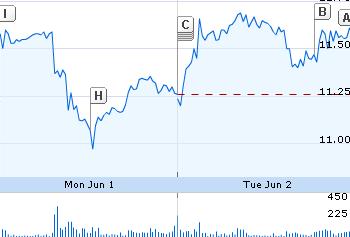
New flight number
After the accident the flight number for the Rio to Paris flight was changed to AF445.